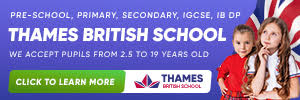On this page:
- What does bilingual education do? What does the research show?
- What does bilingual education involve?
- What’s worth knowing about bilingualism: a summary
- Our Kids recommends
The modern world, and especially the global and domestic labor market, require young people's language skills at a level comparable to their native language. And this isn’t just about the ability to use basic vocabulary and phrases, but about full knowledge of a foreign language, and thus engage in high-level conversation. Fluency of speaking, rich vocabulary, and a good accent are crucial. This can only be ensured by intensive and long-term learning of a foreign language.
What does bilingual education do? What does the research show?
According to psycholinguists, the best period (the so-called critical period for language acquisition) for the acquisition of a foreign language lasts from birth to puberty, and then gradually disappears. According to Professor Ida Kurcz, there’s a lot of evidence that after the critical period, the natural language acquisition ability expires, and this applies primarily to syntax and pronunciation. The later we start learning a given language, the less chance we have to achieve full efficiency in this language, explains Professor Cramp.
So the sooner you start, the better the results will be. Today, no one doubts language learning should start from an early age, because then it takes place naturally. At this stage of development, the child learns languages intuitively, contextually, without learning grammar—just like one’s native language.
“The best learning outcomes are achieved when children start bilingual education at a non-verbal stage, i.e., when they are one or a half years old. They don't speak any language yet, but they have three ladies, each of whom speaks a different language to them. Children do not know what language it is—but they know that it is assigned to the person and if they want to say something to them, they must use it. The later the child begins, the older he is, the harder it will be, because he is already at the verbal stage— that is, he speaks and expects to be understood. And if he suddenly goes to a preschool with a foreign language, at first he doesn't understand anything,” explains Anna Maliszewska, founder of the International Trilingual School of Warsaw.
“The nursery and preschool years are a period of intensive development. Children acquire a second language very quickly, which becomes their next skill. Therefore, the sooner they start bilingual education, the easier it will be for them to develop their language skills for further stages of learning. According to the theory of linguists, the sooner the child begins contact with a second language—auscultation, language melody, tempo, sound—the earlier he begins to utter the sounds that are not in Polish, the easier it will be reach to achieve an accent close to English-speaking people,” argues Aleksandra Siwiak, director of bilingualism in preschool, Ala ma Kota.
However, this approach to language teaching has not always found support. Even in the middle of the last century, the view that bilingualism was more a learning obstacle than an advantage was common. It was believed that the human mind had limited potential and that two languages could not be learned at once, as this leads to less intellectual ability and, as a result, difficulties in mastering each of them. For understandable reasons, bilingual teaching was not recommended, especially to children.
However, studies conducted in the late 1950s in Canada have completely opposite conclusions. Researchers in one school conducted an experiment called immersion, i.e., immersion in the second language taught, and it turned out that for years of study, the children subjected to the experiment were weaker in each of two languages than monolingual peers, but then not only matched them, but surpassed them.
Subsequent studies have only confirmed these observations and the existence of positive relations between language and intelligence. As a result of many years of research, Canadian psychologist Ellen Bialystok has proven that bilingualism in children has a positive effect on their creativity, tolerance of contradictions, and efficiency in solving problems. The advantage of bilingual children over monolingual children boils down to information processing, i.e, it's about ignoring uncertain and misleading information and choosing the right response in tasks where there are competing behavioral possibilities.
It doesn’t have this advantage in tasks related to declarative and analytical knowledge, to making logical inferences from premises. Later studies that Ellen Bialystok together with Ferguson Craik conducted among adults (average 45 years old) and older (average 75 years old) also showed that bilingual people are characterized by greater openness and cognitive flexibility than monolinguals, and that bilingualism delays dementia on average by about four years. And according to Professor Idy Kurcz, the only disadvantage of bilingualism that has been observed is that in tasks involving both languages it delays the time of lexical decisions (language recognition). However, it accelerates non-linguistic and problem-solving cognitive reactions.
It’s important to us that there are no contraindications to early learning of a second language and bilingualism. What's more, bilingual teaching has absolutely no negative impact on the functioning of children with special educational needs (SPEs), and most of them are great at learning and developing a second language. However, you should know that there are situations when it is more important to focus on other needs of the child with SPE, and then learning a foreign language (second language) should be limited.
What does bilingual education involve?
Bilingualism has become desirable today, not only because of communication needs, but also to obtain the advantage that allows you to get a better education, find a better job, and more. That’s why more and more schools are deciding to open bilingual departments or switch to bilingual education.
However, this isn’t about English or Spanish lessons that take place once or twice a week, because they don’t offer much. It’s about language immersion, and above all the method Content and Language Integrated Learning (CLIL). It’s recommended by the European Council and Polish educational authorities as the most effective method of teaching foreign languages.
This method of teaching is increasingly used by Polish schools, preschools, and nurseries. For example, the International Trilingual School of Warsaw, which implements the idea of multilingualism, proposes learning foreign languages (by immersion) from nursery school. The institutions teach children in three selected languages.
“At the Trilingual School, we have classes with English, Spanish, and Polish, as well as French and Chinese. Our children later go to Polish or international schools—it depends on the parents' plans—and they are doing great there. They are able to pass every Polish exam, but at the same time any international exam as well,” emphasizes Anna Maliszewska.
Bilingual education through immersion has been offered by preschool and daycare centres throughout Poland since the beginning of education, including Warsaw's Orange Ciuchcia preschool, in which English begins as early as the age of 2.5, and Spanish is introduced in older groups. Little Academy kindergarten offers a 4-year bilingual program run by teachers certified by the British Council, as well as the largest network of kindergartens, which provide children with the presence of an English-speaking teacher during learning, playing, meals, trips, and other activities.
“In bilingual teaching, the most important thing is the child's contact with the language as often as possible—not only during classes, e.g., for an hour or half an hour during the day, but for most of the day, in every possible situation of a child's life,” explains Aleksandra Siwiak.
In practice, the organization of such learning looks like two teachers working in a group of children—Polish and English.
“They run classes interchangeably—during one activity, one teacher is dominant and the other supports her by adding various things in her language, and vice versa—the next part of the class is conducted by the second, and the first one adds. So in one activity Polish is dominant, in another English. Polish often accompanies younger children, because they do not always understand everything. The rhythm of the day and classes are organized so that children learn different words and language constructions, as well as simple grammatical constructions, so that they can use this language freely according to their current possibilities,” explains the director of bilingualism at AMK.
One should also know that children do not immediately begin to understand what a given teacher is saying to them—it’s a slow process.
“Children who have not had contact with English before have difficulty accepting a teacher who speaks it, because they do not understand it. At the beginning, they also address him in Polish, because only they know it, but that alone confirms acceptance. Only at the next stage do they begin to speak to the teacher in English. That is what we are striving to develop—spoken language—because there is so much we can do with these children. Three-, four-year-olds will not read or write. The point is that contact with the language should be as natural as possible,” emphasizes director Siwiak.
According to Anna Maliszewska, if we want a child to learn a foreign language, three conditions must be met:
- child must be surrounded by as many people as the number of languages they learn and they must be native speakers— according to the principle: one person—one language ;
- the child must spend enough time in this language—it must be long enough and they proportionately immersed in it, and
- the learning methods must be adapted to the child's level of development, mainly his age. One year-olds, three year-olds and fifteen year-olds learn differently.
“It is a bit like playing the piano—if parents want a child to play "a kitty on the fence" during a family party, it is enough to have half an hour to play twice a week. However, if parents want a child to grow up as a virtuoso, he must spend three to five hours a day at the piano. Therefore, for a child to speak a foreign language, two hours a week is not enough—he must be immersed in it on a much larger time scale. There must be regular and frequent learning. And there is no way to avoid this,” emphasizes Anna Maliszewska.
It’s also impossible to skip the stages of learning—the child first begins to understand, and only then begins to talk. Psychologists say that every child living in a society is able to learn the language that the community uses. It’s enough to create such conditions for him, and it depends on his individual capabilities what pace he will master the new language.
What’s worth knowing about bilingualism: a summary
• bilingualism is an advantage, not a disadvantage, and thanks to it, a child gains a headstart at the beginning of education;
• there are no contraindications to bilingual or even trilingual learning—it’s not true that learning in a bilingual system overloads children;
• there’s a simple correlation in learning a foreign language—the earlier we start it, the better its effects will be. The best is to learn from the cradle, because then the child learns a foreign language as well as his native language;
• it’s now recognized that the best results are achieved by the immersion method, and especially CLIL, although in the described models of working with a student, it’s not always the case. It’s important that the child has constant contact with the foreign language taught—two or three hours of lessons per week are not enough;
• bilingual education should not be based solely on preschool or school—it’s also important that the child has contact with the person/persons using language at home and elsewhere;
• one can speak of full bilingualism only when both languages are mastered, not only in speech but also in writing.
Our Kids recommends
We encourage you to read these articles:
Private bilingual elementary schools in Warsaw
People who read this also viewed:
- Warsaw private schools
- Kraków private schools
- Poznań private schools
- Wrocław private schools
- Łódź private schools
- Rzeszów private schools
- Gdańsk & Gdynia private schools
-
Advice Guide
- ABC of educational terminology: Glossary of terms and concepts
- The admissions process
- Advantages and disadvantages of studying in an international school
- The application process
- Benefits of Polish private schools
- Bilingual schools
- Boarding schools
- Choosing a private or nonpublic school in Poland
- Compare schools in Poland
- English schools in Warsaw
- Homeschooling
- International schools in Kraków
- International schools
- Private school interviews
- Music education
- Myths about private education
- Non-public schools in Poland
- School open houses
- Our Kids Interview: Get to know EF Academy Oxford
- Our Kids Interview: Get to know Open School
- Our Kids interview: Get to know Regent College International Schools
- Our Kids Interview: Get to know The American School of Warsaw
- Our Kids Interview: Get to know The British School Warsaw
- Our Kids Interview: Get to know Wrocław Cosmopolitan School (two interviews, new video)
- Poland school profiles
- Private day schools
- Gifted schools & programs
- Private Jewish schools in Poland
- Language schools
- Private school tuition and costs in Poland
- Private schools in Poland
- Private schools in Poland offering French-language immersion
- English immersion schools
- Poland school uniforms
- Public versus non-public schools in Poland
- Private school questions
- Private school rankings
- Reasons for choosing private schools - Our Kids’s survey report
- Religious schools
- Schools and classes for children with ADHD in Poland
- Social Schools
- Special educational needs (SPE) certificates
- Special needs schools
- Study abroad at a private school
- The first annual non-public school fair in Poland
- The first annual Our Kids non-public school expo in Warsaw was a great success
- Third Private School Expo in Warsaw - summary
- Types of schools
- Types of schools in Warsaw
- Warsaw preschool costs
- Why private school?
- Why parents go private
-
Grades
- Boarding high schools
- Choosing a high school in Poland
- Mokotow High School Campus - a new Warsaw high school and Thames British School campus
- Montessori nursery schools
- Montessori preschools
- Our Kids Interview: Get to know FSA School
- Our Kids Interview: Get to know KIDS & Co.
- Our Kids Interview: Get to know Polish British Academy of Warsaw
- Our Kids Interview: Get to know The English Playhouse and The English Primary
- Poland education: grade levels
- Preschools in Warsaw
- Private & non-public preschools
- Private & non-public primary schools
- Private bilingual elementary schools in Warsaw
- Private high schools
- Private high schools in Warsaw
- Private middle schools
- Nursery schools
- Private primary schools in Warsaw
- Social high schools
- Social primary schools
-
Locations
- Boarding schools in Warsaw
- English schools in Kraków
- International Baccalaureate (IB) schools in Warsaw
- International schools in Warsaw
- Montessori schools in Warsaw
- Non-public schools in Warsaw
- Our Kids Interview: Get to know EF Academy
- Our Kids interview: Get to know Excellence in Education better
- Our Kids Interview: Get to know PRIMUS Non-Public Primary School No. 47 and Non-Public Secondary School
- Our Kids Interview: Get to know the Canadian School of Warsaw
- Our Kids Interview: Get to know The Primary and Secondary Schools of the Sisters of Nazareth in Warsaw
- Private Catholic and Christian schools in Warsaw
- Private day schools in Warsaw
- Private language schools in Warsaw
- Private schools in Bialystok
- Bydgoszcz schools
- Częstochowa schools
- Private schools in Gdańsk & Gdynia
- Katowice schools
- Private schools in Krakow
- Lublin schools
- Olsztyn schools
- Private schools in Poznań
- Private schools in Rzeszów
- Szczecin schools
- Private schools Warsaw
- Private schools in Wrocław
- Zielona Góra schools
- Private schools in Łódź
- Private special needs schools in Warsaw







 POL
POL CAN
CAN